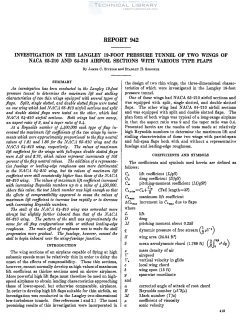naca-report-942

- Version
- 227 Downloads
- 1.57 MB File Size
- 1 File Count
- September 1, 2016 Create Date
- September 1, 2016 Last Updated
National Advisory Committee for Aeronautics, Report - Investigation in the Langley 19 Foot Pressure Tunnel of Two Wings of NACA 65-210 and 64-210 Airfoil Sections with Various Type Flaps

An inrestigation has been conducted in the Langley 19-foot
pressure tunnel to determine the maximum lift and stalling
characteristics of two thin wings equipped with seceral types of
flaps. Split, single slotted, and double slotted flaps were tested
on one wing which had NACA 65—210 airfoil sections and split
and double slotted flaps were tested on the other, which had
NACA 64—210 airfoil sections. Both wings had zero sweep,
an aspect ratio of .9, and a taper ratio of 0.4.
At a Reynolds number of 4,400,000 each type of flap in-
creased the maximum lift coeflicients of the two wings by incre-
ments which were approximately proportional to the flap neutral
values of 1.21 and 1.35 for the NACA-1 65—210 wing and the
NACA-1 64—210 wing, respectirely. The calues of maximum
lift coefiicient for the wings with full-span double slottedflaps
were 2.48 and 2.76, which ralues represent- increments of 105
percent of the flap neutral ralues. The addition of a representa-
tit'e fuselage or leading-edge roughness was more detrimental
to the NACA 64—210 wing, but its mines of maximum lift
coefficient were still consistently higher than those of the NAG-1
65—210 wing. The calues of maximum lift coeficient increased
with increasing Reynolds numbers up to a ralue of 4,400,000.
Aboce this value. the test JIach number was high enough so that
the ejects of compressibility appeared to cause the values of
maximum lift coejicient to increase less rapidly or to decrease
with increasing Reynolds numbers.
The stall of the NACA-1 64—210 wing was somewhat more
abrupt but slightly farther inboard than that of the NAG-i
65—210 wing. The pattern of the stall was approximately the
same for all flap configurations with or without leading-edge
roughness. The main effect of roughness was to make the stall
progression more gradual. The fuselage, howeeer, caused the
stall to begin inboard near the wing fuselage junction.
| File | Action |
|---|---|
| naca-report-942 Investigation in the Langley 19 Foot Pressure Tunnel of Two Wings of NACA 65-210 and 64-210 Airfoil Sections with Various Type Flaps.pdf | Download |

Comment On This Post